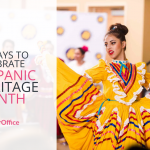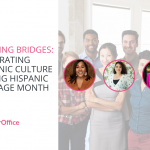23 Sep Hispanic Heritage Month: The Essentials

Hispanic Heritage Month is a period of celebration and recognition in the United States intended to pay tribute to the contributions, cultures, histories, and achievements of Hispanic and Latino Americans. It is observed annually from September 15 to October 15. During this time, organizations host various events, activities, and programs to honor the diverse Hispanic communities and their rich heritage.
Hispanic Heritage Month first began as a week-long celebration. It was first established in 1968 by President Lyndon B. Johnson as National Hispanic Heritage Week. The date chosen for the celebration aligns with the independence days of several Latin American countries, including Costa Rica, El Salvador, Guatemala, Honduras, and Nicaragua, declaring their independence from Spain on September 15, 1821. Mexico followed on September 16, and Chile on September 18. The celebration was later expanded to a month-long observance by President Ronald Reagan in 1988.
Hispanic Heritage Month is a celebration of a single culture and a tapestry of diverse cultures, traditions, and histories. It acknowledges the numerous Spanish-speaking nations and their unique contributions to American society. From the colorful traditions of Mexican mariachi music to the flavorful cuisine of Cuba, and from the rhythmic dances of the Dominican Republic to the influential literature of Chile, the month provides a platform for people of Hispanic and Latino descent to showcase and share their heritage.

Why it is Essential to Celebrate Hispanic Heritage Month in the Workplace
Organizations must take time during this month to highlight the diversity of the Hispanic and Latino communities, each with their unique traditions. They need to ensure the events and activities planned to bring employees together to learn and celebrate are inclusive, acknowledging the diversity of the Hispanic heritage to help build solid relationships and a sense of unity among team members that transcend cultural barriers.
Overall, the diversity within the workplace is expanding. Data from the U.S. Bureau of Labor Statistics (BLS) shows the number of Hispanic workers in the labor force has grown from 10.7 million in 1990 to 29.0 million in 2020 and is projected to reach 35.9 million by 2030. Additionally, Hispanics will account for 78% of net new workers between 2020 and 2030. In fact, with the U.S. labor force growth rate slowing over the past couple of decades, the growth is primarily due to the increasing number of Hispanic workers.
Recognizing Hispanic Heritage Month demonstrates a commitment to fostering an inclusive and diverse workplace. It sends a powerful message that people of all backgrounds are valued and respected. This inclusivity can lead to increased employee morale, engagement, and a sense of belonging, which in turn, can enhance productivity and retention rates.
Celebrating Hispanic Heritage Month allows employees to learn about the rich and diverse cultures, traditions, and contributions of Hispanic and Latino communities. This increased cultural awareness helps break down stereotypes, reduce bias, and promote greater understanding among colleagues.
For Hispanic and Latino employees, celebrating their heritage in the workplace can be empowering. It validates their identities, encourages them to share their perspectives, and fosters a sense of pride in their cultural heritage. This empowerment can increase self-confidence and a stronger sense of engagement with the company.
Actions Organizations Can Take to Celebrate Hispanic Heritage Month
Organizations can take several actions to honor and celebrate Hispanic Heritage Month. Here are some ideas:
-
• Use internal communication channels such as newsletters, intranets, and social media platforms to share stories, profiles, and educational content related to Hispanic heritage. Storytelling can raise awareness and foster a sense of inclusion within the organization.
• Invite Hispanic professionals, scholars, artists, and community leaders to speak or participate in panel discussions. These events can provide an opportunity to learn about their experiences, perspectives, and contributions in various fields.
• Encourage the formation of Hispanic or Latino Employee Resource Groups (ERGs) within the organization and leverage them to help determine and execute activities such as lunch and learn sessions, workshops, or mentorship programs to celebrate and educate others about Hispanic culture.
• Organize screenings of films by Hispanic filmmakers or host book clubs focusing on works by Hispanic authors. Showing these films and books can promote dialogue, understanding, and appreciation for Hispanic culture and literature.
• Collaborate with Hispanic-owned businesses or organizations to create joint initiatives, events, or promotions celebrating Hispanic culture. These partnerships can strengthen relationships and demonstrate support for the Hispanic community.
• Encourage employees to engage in volunteer activities that support Hispanic communities. Collaborate with local Hispanic organizations or nonprofits to identify volunteer opportunities that address community needs.
For more questions or comments and to discuss diversity, equity, and inclusion in your workplace, please do not hesitate to reach out to us at DEI@ouroffice.io. Our team is here to support you in any way we can.




